跨文化交流与沟通结课作业.
- 格式:doc
- 大小:11.50 KB
- 文档页数:2

《跨文化商务沟通》第一章文化、沟通及跨文化沟通课后练习一、单项选择题共12 题1、Cultural bias is unavoidable since there was a long process of culture ()in world history.A . separationB . communicationC . progressD . communicat参考答案:A2、Although there are many cultural barriers among different cultures, there are also certain proper channels to()among different nations.A . argumentB . communicateC . disputeD . transport参考答案:B3、Culture has variety of characteristics but not ().A . sharedB . learnedC . ethnocentricD . invariability参考答案:D4、Only outward symbols of a culture are visible, while the most important aspects of a culture are invisible. This phenomenon is often compared as a metaphor ().A . blanketB . icebergC . iceboxD . invisible man参考答案:B5、()The communication between people from different cultures when a member of one culture produces a message for consumption by a member of another culture.A . business communicationB . cultural communicationC . intercultural communicationD . vertical communication参考答案:C6、()A process by which information is exchanged between individuals through a common system of symbols, signs, or behavior, or the exchange of thoughts, messages, or information, as by speech, signals, writing, or behavior.A . communicationB . messageC . informationD . transformation参考答案:A7、()The communication is within business and administration, aiming at a common objective and profits for both the individuals and organizations.A . cultural exchangeB . business exchangeC . business communicationD . intercultural communication参考答案:C8、Culture and language are not the same, but they ().A . link each otherB . are essentially differentC . can be substituted each otherD . have different aspects参考答案:A9、()The belief that your own cultural background, including ways of analyzing problems, values, beliefs, language, and verbal and nonverbal communication, is superior.A . communicationB . cultureC . prejudiceD . ethnocentrism参考答案:D10、()The total accumulation of beliefs, customs, values, behaviors, institutions and communication patterns that are shared, learned and passed down through the generations in an identifiable group of people.A . cultureB . beliefC . environmentD . institution参考答案:A11、()The communication at the same level in an organization.。

1.1眼神。
“眼睛是心灵的窗户”,无论那个国家交际活动都离不开目光交流,但是目光的交流含义又因不同的文化而不同。
中国人认为紧盯着对方的目光会令人不安;在美国,谈话时的目光接触表示自信、诚恳,但要注意的是,男人之间的长时间凝视有可能被误认为是同性恋;英国男人交往直视对方的眼睛体现绅士风度;在南美,直接的注视则表示信任;阿拉伯人在倾听尊长或宾朋谈话时,两眼总要直勾勾地注视着对方,以示敬重;法国人在公共场合凝视陌生女性见惯不怪,那是欣赏对方的美丽;日本人、韩国人认为长时间看着别人是一种粗鲁的行为,是威胁对方,或者可能是性欲暗示。
In fact, Westerners lack of eye contact as a lack of interest.要注意眼神交流,西方人的交往中特别注重眼神和肢体语言的交流,如果你常常微笑,常常给外教眼神回应,他们会觉得你真正地在参与交流,而且很尊重他,他会自然而然地很注意你的回应,并与你作更深层次的交谈。
别不相信,外教自己也会紧张,你的眼神甚至还可以帮助他觉得舒服和自然,就更容易投入交流了。
1,在欧美文化中,没有眼神的沟通几乎是不可能的,与对方讲话时,或听对方讲话时,一定眼看着对方,否者将被视为对谈话内容没有兴趣,或心理有鬼不敢正视对方,或是性格过于羞怯。
就是在低位不相等的人之间也是如此。
2.但在东方文化中,目光接触就不一定要有。
但两个地位不等的人对话时,地位低的那一个一般不看对方,因为只是会被认为是一种不尊重的行为。
中国人和西方人之间在目光交流方面的确存在一些难以具体描述的差异。
西方人的目光交流尽管不如阿拉伯国家的人那样热烈,却比中国人热情得多。
中国人总不断地抱怨西方人在交谈时总爱死盯着人,甚至在公开谈话的场合也不例外。
毋庸置疑,西方人较注重眼色交流,实际上眼色交流也比中国人频繁得多。
用反应原则作一推测,就可以预料到西方人可能会发现中国人表情羞羞答答,目光躲躲闪闪,认为其时故作腼腆。

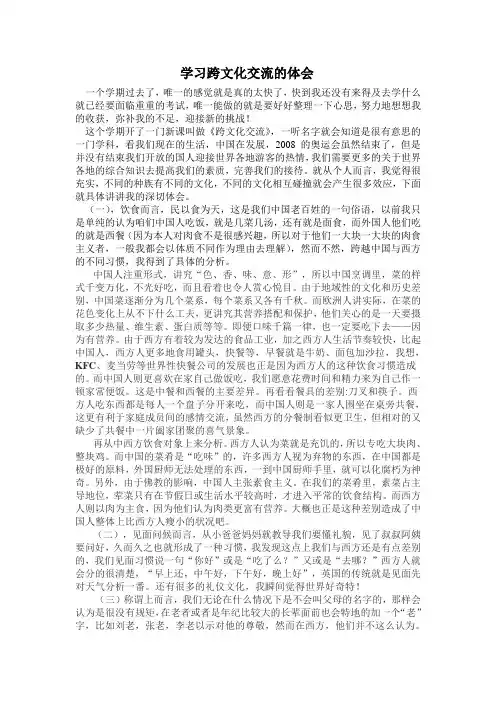
学习跨文化交流的体会一个学期过去了,唯一的感觉就是真的太快了,快到我还没有来得及去学什么就已经要面临重重的考试,唯一能做的就是要好好整理一下心思,努力地想想我的收获,弥补我的不足,迎接新的挑战!这个学期开了一门新课叫做《跨文化交流》,一听名字就会知道是很有意思的一门学科,看我们现在的生活,中国在发展,2008的奥运会虽然结束了,但是并没有结束我们开放的国人迎接世界各地游客的热情,我们需要更多的关于世界各地的综合知识去提高我们的素质,完善我们的接待。
就从个人而言,我觉得很充实,不同的种族有不同的文化,不同的文化相互碰撞就会产生很多效应,下面就具体讲讲我的深切体会。
(一),饮食而言,民以食为天,这是我们中国老百姓的一句俗语,以前我只是单纯的认为咱们中国人吃饭,就是几菜几汤,还有就是面食,而外国人他们吃的就是西餐(因为本人对肉食不是很感兴趣,所以对于他们一大块一大块的肉食主义者,一般我都会以体质不同作为理由去理解),然而不然,跨越中国与西方的不同习惯,我得到了具体的分析。
中国人注重形式,讲究“色、香、味、意、形”,所以中国烹调里,菜的样式千变万化,不光好吃,而且看着也令人赏心悦目。
由于地域性的文化和历史差别,中国菜逐渐分为几个菜系,每个菜系又各有千秋。
而欧洲人讲实际,在菜的花色变化上从不下什么工夫,更讲究其营养搭配和保护,他们关心的是一天要摄取多少热量、维生素、蛋白质等等。
即便口味千篇一律,也一定要吃下去——因为有营养。
由于西方有着较为发达的食品工业,加之西方人生活节奏较快,比起中国人,西方人更多地食用罐头,快餐等,早餐就是牛奶、面包加沙拉,我想,KFC、麦当劳等世界性快餐公司的发展也正是因为西方人的这种饮食习惯造成的。
而中国人则更喜欢在家自己做饭吃,我们愿意花费时间和精力来为自己作一顿家常便饭。
这是中餐和西餐的主要差异。
再看看餐具的差别:刀叉和筷子。
西方人吃东西都是每人一个盘子分开来吃,而中国人则是一家人围坐在桌旁共餐,这更有利于家庭成员间的感情交流,虽然西方的分餐制看似更卫生,但相对的又缺少了共餐中一片阖家团聚的喜气景象。
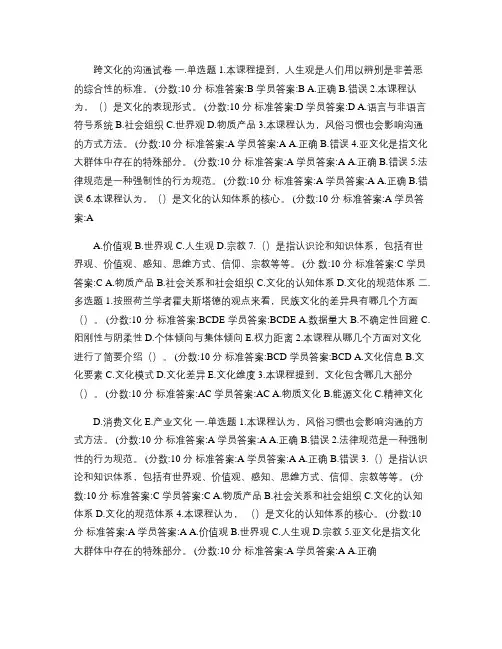
跨文化的沟通试卷一.单选题 1.本课程提到,人生观是人们用以辨别是非善恶的综合性的标准。
(分数:10 分标准答案:B 学员答案:B A.正确 B.错误 2.本课程认为,()是文化的表现形式。
(分数:10 分标准答案:D 学员答案:D A.语言与非语言符号系统 B.社会组织 C.世界观 D.物质产品 3.本课程认为,风俗习惯也会影响沟通的方式方法。
(分数:10 分标准答案:A 学员答案:A A.正确 B.错误 4.亚文化是指文化大群体中存在的特殊部分。
(分数:10 分标准答案:A 学员答案:A A.正确 B.错误 5.法律规范是一种强制性的行为规范。
(分数:10 分标准答案:A 学员答案:A A.正确 B.错误 6.本课程认为,()是文化的认知体系的核心。
(分数:10 分标准答案:A 学员答案:AA.价值观B.世界观C.人生观D.宗教 7.()是指认识论和知识体系,包括有世界观、价值观、感知、思维方式、信仰、宗教等等。
(分数:10 分标准答案:C 学员答案:C A.物质产品 B.社会关系和社会组织 C.文化的认知体系 D.文化的规范体系二.多选题 1.按照荷兰学者霍夫斯塔德的观点来看,民族文化的差异具有哪几个方面()。
(分数:10 分标准答案:BCDE 学员答案:BCDE A.数据量大 B.不确定性回避 C.阳刚性与阴柔性 D.个体倾向与集体倾向E.权力距离 2.本课程从哪几个方面对文化进行了简要介绍()。
(分数:10 分标准答案:BCD 学员答案:BCD A.文化信息 B.文化要素 C.文化模式 D.文化差异 E.文化维度 3.本课程提到,文化包含哪几大部分()。
(分数:10 分标准答案:AC 学员答案:AC A.物质文化 B.能源文化 C.精神文化D.消费文化E.产业文化一.单选题 1.本课程认为,风俗习惯也会影响沟通的方式方法。
(分数:10 分标准答案:A 学员答案:A A.正确 B.错误 2.法律规范是一种强制性的行为规范。
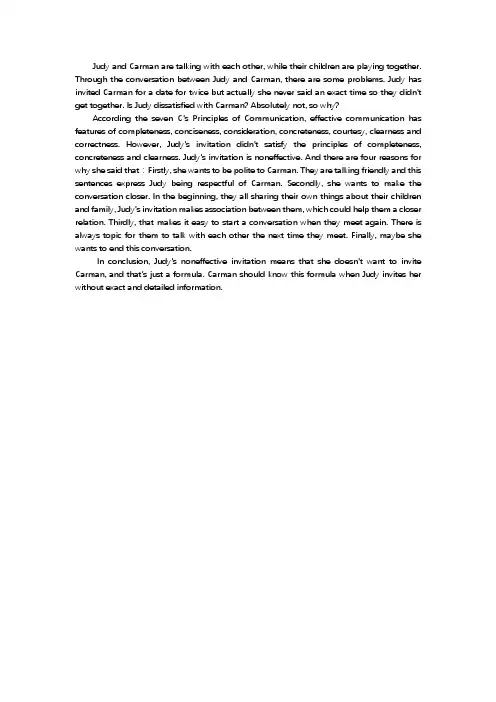
Judy and Carman are talking with each other, while their children are playing together. Through the conversation between Judy and Carman, there are some problems. Judy has invited Carman for a date for twice but actually she never said an exact time so they didn’t get together. Is Judy dissatisfied with Carman? Absolutely not, so why?According the seven C’s Principles of Communication, effective communication has features of completeness, conciseness, consideration, concreteness, courtesy, clearness and correctness. However, Judy’s invitation didn’t satisfy the principles of completeness, concreteness and clearness. Judy’s invitation is noneffective. And there are four reasons for why she said that:Firstly, she wants to be polite to Carman. They are talking friendly and this sentences express Judy being respectful of Carman. Secondly, she wants to make the conversation closer. In the beginning, they all sharing their own things about their children and family, Judy’s invitation makes association between them, which could help them a closer relation. Thirdly, that makes it easy to start a conversation when they meet again. There is always topic for them to talk with each other the next time they meet. Finally, maybe she wants to end this conversation.I n conclusion, Judy’s noneffective invitation means that she doesn’t want to invite Carman, and that’s just a formula. Carman should know this formula when Judy invites her without exact and detailed information.。
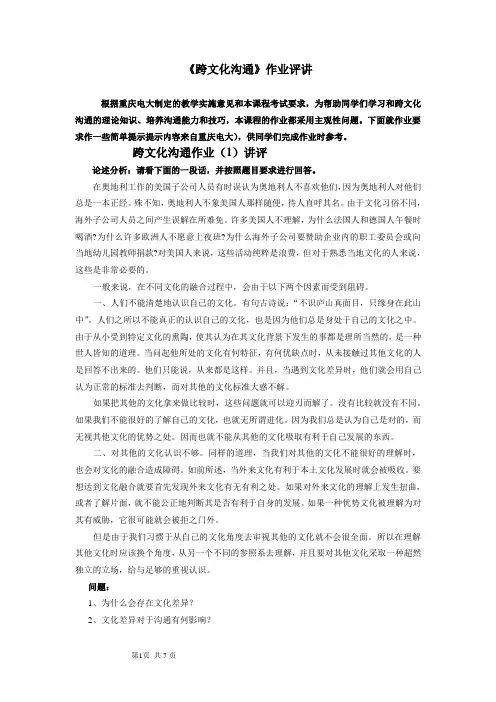
《跨文化沟通》作业评讲根据重庆电大制定的教学实施意见和本课程考试要求,为帮助同学们学习和跨文化沟通的理论知识、培养沟通能力和技巧,本课程的作业都采用主观性问题。
下面就作业要求作一些简单提示提示内容来自重庆电大),供同学们完成作业时参考。
跨文化沟通作业(1)讲评论述分析:请看下面的一段话,并按照题目要求进行回答。
在奥地利工作的美国子公司人员有时误认为奥地利人不喜欢他们,因为奥地利人对他们总是一本正经。
殊不知,奥地利人不象美国人那样随便,待人直呼其名。
由于文化习俗不同,海外子公司人员之间产生误解在所难免。
许多美国人不理解,为什么法国人和德国人午餐时喝酒?为什么许多欧洲人不愿意上夜班?为什么海外子公司要赞助企业内的职工委员会或向当地幼儿园教师捐款?对美国人来说,这些活动纯粹是浪费,但对于熟悉当地文化的人来说,这些是非常必要的。
一般来说,在不同文化的融合过程中,会由于以下两个因素而受到阻碍。
一、人们不能清楚地认识自己的文化。
有句古诗说:“不识庐山真面目,只缘身在此山中”。
人们之所以不能真正的认识自己的文化,也是因为他们总是身处于自己的文化之中。
由于从小受到特定文化的熏陶,使其认为在其文化背景下发生的事都是理所当然的,是一种世人皆知的道理。
当问起他所处的文化有何特征,有何优缺点时,从未接触过其他文化的人是回答不出来的。
他们只能说,从来都是这样。
并且,当遇到文化差异时,他们就会用自己认为正常的标准去判断,而对其他的文化标准大惑不解。
如果把其他的文化拿来做比较时,这些问题就可以迎刃而解了。
没有比较就没有不同。
如果我们不能很好的了解自己的文化,也就无所谓进化。
因为我们总是认为自己是对的,而无视其他文化的优势之处。
因而也就不能从其他的文化吸取有利于自己发展的东西。
二、对其他的文化认识不够。
同样的道理,当我们对其他的文化不能很好的理解时,也会对文化的融合造成障碍。
如前所述,当外来文化有利于本土文化发展时就会被吸收。

跨文化沟通期末总结引言跨文化沟通成为现代社会中一个重要的议题。
随着全球化的加速发展和科技的不断进步,人们之间的距离逐渐缩小,文化差异开始变得突出。
有效的跨文化沟通能够促进各国之间的合作和理解,但是由于语言、价值观、传统习俗等因素的不同,跨文化沟通也面临着种种挑战。
本文将总结我在本学期学习跨文化沟通课程中的收获和体会,并就如何通过有效的跨文化沟通来应对跨文化交流中的挑战提出一些建议。
一、跨文化沟通的概念和重要性跨文化沟通是指在不同文化背景下进行的信息交流和理解的过程。
在全球化的背景下,越来越多的人们需要与来自不同文化背景的人进行交流和合作,而有效的跨文化沟通是构建和谐社会关系的基石。
跨文化沟通的重要性体现在以下几个方面:1. 促进理解和合作:跨文化沟通可以帮助不同文化背景的人更好地理解彼此的观点和行为,从而促进合作和共同发展。
2. 强化文化认同:通过跨文化沟通,人们可以更深入地了解其他文化的内涵和特点,从而增强自己的文化认同感。
3. 扩大视野:跨文化沟通能够帮助人们拓宽自己的视野,了解其他文化的智慧和经验,从而提升个人素质。
二、跨文化沟通的挑战和解决办法1. 语言障碍:不同国家和地区使用不同的语言,语言差异成为跨文化沟通过程中最常见的问题之一。
解决办法是学习对方的语言,或者借助翻译工具进行沟通。
2. 价值观差异:不同文化对于价值观念的理解和追求存在差异。
解决办法是尊重对方的价值观,并且学会换位思考,理解对方的观点。
3. 行为习惯和礼仪:不同文化对于行为习惯和礼仪的要求也存在差异。
解决办法是学习对方的习俗和礼仪,并且在交流过程中尊重对方的文化习惯。
4. 信任和建立关系:跨文化交流中建立信任和良好关系是非常重要的。
解决办法是建立良好的沟通和互动方式,通过共同利益和合作来增强信任。
三、有效跨文化沟通的方法和技巧1. 学习对方的语言和文化:学习对方的语言可以帮助我们更好地理解和表达自己的观点。
同时,了解对方的文化可以帮助我们更好地理解对方的行为和思维方式。
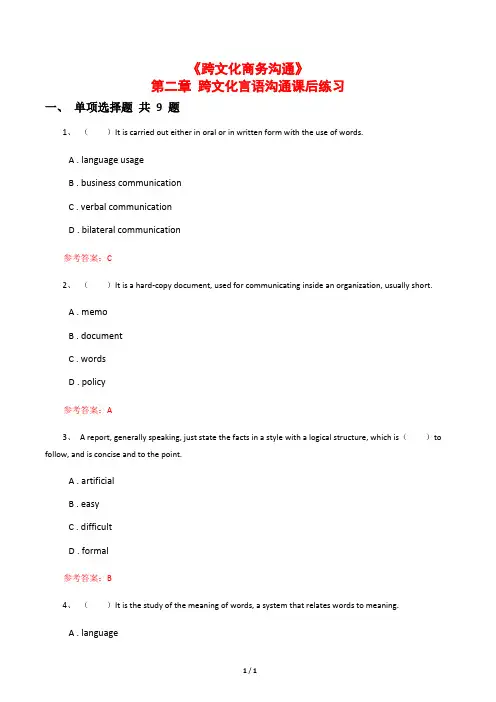
《跨文化商务沟通》第二章跨文化言语沟通课后练习一、单项选择题共9 题1、()It is carried out either in oral or in written form with the use of words.A . language usageB . business communicationC . verbal communicationD . bilateral communication参考答案:C2、()It is a hard-copy document, used for communicating inside an organization, usually short.A . memoB . documentC . wordsD . policy参考答案:A3、A report, generally speaking, just state the facts in a style with a logical structure, which is()to follow, and is concise and to the point.A . artificialB . easyC . difficultD . formal参考答案:B4、()It is the study of the meaning of words, a system that relates words to meaning.A . languageB . communicationC . pragmaticsD . semantics参考答案:D5、Letter writing is very important in business communication. And a good letter is(), straight forward, and polite.A . courteousB . rhetoricC . euphemisticD . brief参考答案:D6、()It is the study of how speakers use the language to reach successful communication, and the study of the effect that language has on human perceptions and behaviors.A . semanticsB . pragmaticsC . communicationD . language参考答案:B7、()It is a set of symbols and the rules for combining those symbols and rules that are used and understood by a large community of people.A . languageB . semanticsC . pragmaticsD . communication参考答案:A8、Written document is more()than making a call.A . convenientB . efficientC . formalD . stereotype参考答案:C9、Verbal communication includes()communication and written communication.A . oralB . speakingC . talkingD . discussing参考答案:A二、判断题共9 题1、Verbal communication is the transferring of thoughts between individuals only via spoken messages.对错参考答案:错误2、Semantics is a system that relates words to meaning, which is easy to follow and can never be misunderstood by people.对错。

《跨文化商务沟通》第一章文化、沟通及跨文化沟通课后练习一、单项选择题共12 题1、Cultural bias is unavoidable since there was a long process of culture ()in world history.A . separationB . communicationC . progressD . communicat参考答案:A2、Although there are many cultural barriers among different cultures, there are also certain proper channels to()among different nations.A . argumentB . communicateC . disputeD . transport参考答案:B3、Culture has variety of characteristics but not ().A . sharedB . learnedC . ethnocentricD . invariability参考答案:D4、Only outward symbols of a culture are visible, while the most important aspects of a culture are invisible. This phenomenon is often compared as a metaphor ().A . blanketB . icebergC . iceboxD . invisible man参考答案:B5、()The communication between people from different cultures when a member of one culture produces a message for consumption by a member of another culture.A . business communicationB . cultural communicationC . intercultural communicationD . vertical communication参考答案:C6、()A process by which information is exchanged between individuals through a common system of symbols, signs, or behavior, or the exchange of thoughts, messages, or information, as by speech, signals, writing, or behavior.A . communicationB . messageC . informationD . transformation参考答案:A7、()The communication is within business and administration, aiming at a common objective and profits for both the individuals and organizations.A . cultural exchangeB . business exchangeC . business communicationD . intercultural communication参考答案:C8、Culture and language are not the same, but they ().A . link each otherB . are essentially differentC . can be substituted each otherD . have different aspects参考答案:A9、()The belief that your own cultural background, including ways of analyzing problems, values, beliefs, language, and verbal and nonverbal communication, is superior.A . communicationB . cultureC . prejudiceD . ethnocentrism参考答案:D10、()The total accumulation of beliefs, customs, values, behaviors, institutions and communication patterns that are shared, learned and passed down through the generations in an identifiable group of people.A . cultureB . beliefC . environmentD . institution参考答案:A11、()The communication at the same level in an organization.A . vertical communicationB . horizontal communicationC . business communicationD . directive communication参考答案:B12、Lateral communication could be expressed as ().A . single communicationB . prejudice communicationC . directive communicationD . horizontal communication参考答案:D二、判断题共12 题1、Culture could be understood as variety of ways of social lives for different nation or groups in the world.对错参考答案:正确2、With the integration of language into the fabric of culture, confusion and dysfunction would happen and the culture would be destroyed.对错参考答案:错误3、Culture is all men's medium; there is no aspect of human life that is not touched and altered by culture.对错参考答案:正确4、The culture shown in an onion consists of two levels: a level of norms and values, or an invisible level, and a visible level of resultant behavior or artifacts of' some form.对错参考答案:正确5、Culture cannot be known without a study of communication, and communication can only be understood with an understanding of the culture it supports.对错参考答案:正确6、In the global village, neighbors communicate free of troubles and difficulties.对错参考答案:错误7、Culture could be understood as the only universal way of life in the world.对错参考答案:错误8、The terms of intercultural communication and international communication can be used interchangeably.对错参考答案:正确9、Intercultural communication could be the communication between persons of different cultures.对错参考答案:正确10、Stereotypes, like culture itself, are learned in a variety of ways. They are the products of limited, lazy, and misguided perceptions.对错参考答案:正确11、The culture shown in an iceberg consists of two levels: a level of norms and values, like an invisible iceberg under sea level, and a visible level of characteristics, like the visible iceberg above sea level.对错参考答案:正确12、It is impossible for us to communicate with another totally different culture.对错参考答案:错误三、简答题共 3 题1、有人说,“掌握了对方的语言,就消除了跨文化沟通的障碍”。
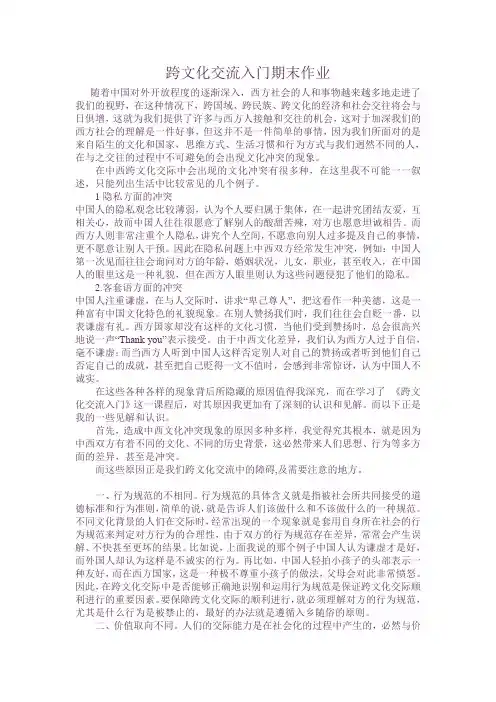
跨文化交流入门期末作业随着中国对外开放程度的逐渐深入,西方社会的人和事物越来越多地走进了我们的视野,在这种情况下,跨国域、跨民族、跨文化的经济和社会交往将会与日俱增,这就为我们提供了许多与西方人接触和交往的机会,这对于加深我们的西方社会的理解是一件好事,但这并不是一件简单的事情,因为我们所面对的是来自陌生的文化和国家,思维方式、生活习惯和行为方式与我们迥然不同的人,在与之交往的过程中不可避免的会出现文化冲突的现象。
在中西跨文化交际中会出现的文化冲突有很多种,在这里我不可能一一叙述,只能列出生活中比较常见的几个例子。
1隐私方面的冲突中国人的隐私观念比较薄弱,认为个人要归属于集体,在一起讲究团结友爱,互相关心,故而中国人往往很愿意了解别人的酸甜苦辣,对方也愿意坦诚相告。
而西方人则非常注重个人隐私,讲究个人空间,不愿意向别人过多提及自己的事情,更不愿意让别人干预。
因此在隐私问题上中西双方经常发生冲突,例如:中国人第一次见面往往会询问对方的年龄,婚姻状况,儿女,职业,甚至收入,在中国人的眼里这是一种礼貌,但在西方人眼里则认为这些问题侵犯了他们的隐私。
2.客套语方面的冲突中国人注重谦虚,在与人交际时,讲求“卑己尊人”,把这看作一种美德,这是一种富有中国文化特色的礼貌现象。
在别人赞扬我们时,我们往往会自贬一番,以表谦虚有礼。
西方国家却没有这样的文化习惯,当他们受到赞扬时,总会很高兴地说一声“Thank you”表示接受。
由于中西文化差异,我们认为西方人过于自信,毫不谦虚;而当西方人听到中国人这样否定别人对自己的赞扬或者听到他们自己否定自己的成就,甚至把自己贬得一文不值时,会感到非常惊讶,认为中国人不诚实。
在这些各种各样的现象背后所隐藏的原因值得我深究,而在学习了《跨文化交流入门》这一课程后,对其原因我更加有了深刻的认识和见解。
而以下正是我的一些见解和认识。
首先,造成中西文化冲突现象的原因多种多样,我觉得究其根本,就是因为中西双方有着不同的文化、不同的历史背景,这必然带来人们思想、行为等多方面的差异,甚至是冲突。
高中一年级英语作业的跨文化交流实践在高中一年级的英语课堂上,作业不仅仅是知识的传递,它更像是一座桥梁,连接着不同文化之间的交流。
每当老师布置一项与跨文化主题相关的作业时,学生们的眼中总会闪烁着好奇的光芒。
他们知道,这不仅是一次语言练习,更是一次心灵的探险。
作业的内容常常涉及到不同国家的风俗习惯、节日庆典以及日常生活。
比如,学生们可能被要求研究西方的感恩节和中国的中秋节。
他们兴致勃勃地查阅资料,了解这两个节日背后的故事和传统,试图去感受那种跨越国界的温暖与团聚。
通过这样的作业,学生们不仅学习到了英语词汇,还体会到了文化的深度和广度。
在进行这些作业时,学生们仿佛变成了文化的使者。
他们通过文字将自己的发现与同学分享,带领大家走进一个个陌生而又迷人的文化世界。
课堂讨论中,来自不同背景的学生各抒己见,分享他们的观点和体验。
这种互动不仅增强了他们的语言表达能力,也培养了对多元文化的理解和尊重。
除了传统的书面作业,现代科技为跨文化交流提供了更多的可能性。
学生们可以利用社交媒体和在线平台,与来自世界各地的同龄人进行沟通与交流。
在一次作业中,一位学生通过视频聊天与美国的同学讨论各自国家的学校生活。
他们用英语畅所欲言,分享着不同国家的教育理念和校园文化。
这样的经历,不仅提高了语言水平,更让学生们感受到世界是如此之大,而他们又是如此紧密相连。
在这个过程中,英语不仅是一门学科,更是打开世界的一把钥匙。
学生们通过英语作业,了解到了其他文化的独特之处,明白了尊重与包容的重要性。
他们在讨论中学会了倾听,在交流中学会了思考,这些能力将伴随他们终生。
此外,跨文化交流作业还能够激发学生的创造力与想象力。
在一次关于国际美食的作业中,学生们被要求制作一道融合了中西方元素的菜肴。
他们在厨房里忙碌,尝试将中国的饺子和意大利的披萨结合在一起,创造出一种新的口味。
这不仅是一次美食的探索,更是文化的碰撞与融合。
通过亲身实践,他们体会到文化不再是高高在上的概念,而是生活中真实而可感的体验。
跨文化交流作业名词解释1. Ethnorelativism2. Ethnocentrism3. Collectivist culture4. Culture shock5. Non-verbal communication6. Individualism7. Low-context culture问答题1. Describe the different ways in showing hospitality between Chinese culture and western culture2. What are the differences on receiving gifts between Chinese and westerner?3. Why do many Chinese people tend to ask about age, martial status, and even salary when first meeting one another?4. What is the significance of Nonverbal Communication?5. Explain high-context culture and low-context culture.答案:名词解释1. Ethnorelativism :It is the attitude of cultural relativism, sometimes called “Ethnorelativism”. An acquired ab ility to see many values and behaviors as cultural rather than universal。
2. Ethnocentrismis negatively judging aspects of another culture by the standards of one…s own culture. It is the technical name for the view of things in which one…s own group is the center of everything, and all others are scaled and rated with reference to it.3. Collectivist culture:it is characterized by a rigid social framework that distinguish between in-groups and out-groups .people expect their in-group to look after them ,and in exchange for that they fell they owe absolute loyalty to the group .collectivism means greater emphasis on (1)the views ,needs ,and goals of the in-groups rather than oneself(2)social norms and duty defined by the in-group rather than behavior to get pleasure(3)beliefs shared with the in-group; rather than beliefs that distinguish self from in group ; and (4)great readiness to cooperate with in group membership .4. Culture shockIt is a psychological phenomenon that is experienced most often by those who, whether voluntarily or involuntarily, in the process of adjusting themselves to a new culture.5. Nonverbal communication:It refers to communication through a whole variety of different types of signal come into play, including the way we move, the gestures we employ, the posture we adopt, the facial expression we wear, the direction of our gaze, to the extent to which we touch and the distance we stand from each other.6. Individualismbroadly speaking ,individualism refers to the doctrine theater the interests of the individual are of ought to be paramount ,and that all values ,rights and duties originate in individual s ,it emphasizes individual initiative ,independence ,individual expression ,and even privacy .7. Low-context cultureit's a kind of culture in which the population is lesshomogeneous and therefore tends to compartmentalize interpersonal contacts ,e.g. American ,German简答题:1. Describe the different ways in showing hospitality between Chinese culture and western culture。
《跨文化商务沟通》第二章跨文化言语沟通课后练习《跨文化商务沟通》第二章跨文化言语沟通课后练习一、单项选择题共9 题1、()It is carried out either in oral or in written form with the use of words.A . language usageB . business communicationC . verbal communicationD . bilateral communication参考答案:C2、()It is a hard-copy document, used for communicating inside an organization, usually short.A . memoB . documentC . wordsD . policy参考答案:A3、A report, generally speaking, just state the facts in a style with a logical structure, which is()to follow, and is concise and to the point.A . artificialB . easyC . difficultD . formal参考答案:B4、()It is the study of the meaning of words, a system that relates words to meaning.A . languageB . communicationC . pragmaticsD . semantics参考答案:D5、Letter writing is very important in business communication. And a good letter is(), straight forward, and polite.A . courteousB . rhetoricC . euphemisticD . brief参考答案:D6、()It is the study of how speakers use the language to reach successful communication, and the study of the effect that language has on human perceptions and behaviors.A . semanticsB . pragmaticsC . communicationD . language参考答案:B7、()It is a set of symbols and the rules for combining those symbols and rules that are used and understood by a large community of people.A . languageB . semanticsC . pragmaticsD . communication参考答案:A8、Written document is more()than making a call.A . convenientB . efficientC . formalD . stereotype参考答案:C9、Verbal communication includes()communication and written communication.A . oralB . speakingC . talkingD . discussing参考答案:A二、判断题共9 题1、Verbal communication is the transferring of thoughts between individuals only via spoken messages.对错参考答案:错误2、Semantics is a system that relates words to meaning, which is easy to follow and can never be misunderstood by people.对错。
金融1301 康鹏飞中国自古以来就提倡“孝道”、“尊老”,并衍生出独特而纯粹的“孝”文化;而西方则因其注重个性与自我的文化氛围,衍生出完全不同的“待老,待亲”文化。
中国孝文化有着重要的政治内涵。
“孝”本是规范家庭内部亲子关系的伦理道德,主要指子女对父母的道德义务,是家庭伦理的范畴之一。
但传统的中国社会是家国同构、君父同伦,正如孔子所言“君君、臣臣、父父、子子”,“孝”也就具有了重要的政治意义。
“普天之下莫非王土,率土之宾莫非王臣。
”君为天下父,行孝道就是行忠道,忠孝是一体的。
在统治者看来,忠孝观念是每个社会成员必须遵守的规范。
无论家与国,其权力配置都是严格的父家长制,而皇帝通常被称为君父,皇帝派遣的官吏、地方行政官员则被视为老百姓的“父母官”。
“以孝治天下”成了历代君王成功施政的经验总结。
可见,在传统的中国社会,孝文化不仅仅局限于单纯地敬养父母,已经明显地扩展和泛化了。
《孝经?开宗明义》认为:“身体发肤,受之父母,不敢毁伤,孝之始也;立身行道,扬名于后世,以显父母,孝之终也。
夫孝,始于事亲,中于事君,终于立身。
”孝敬父母只是孝的开始,进德修业才是孝之终。
这与儒家伦理“修身、齐家、治国、平天下”的思想相一致,与儒家“身—家—国”的模式相统一。
可见,“孝”已经同时向个体道德领域和政治领域扩展,它起源于个体道德修养,贯穿于家庭中赡养父母和家庭和睦,终于进德修业,对国家和社会履行职责。
而西方历史上,不仅没有把“孝廉”作为人才选拔的要求,也很少有政府或统治者会公开宣扬“孝道”,甚至在讲求法治的西方社会中,大多数国家甚至对于“子女必须抚养父母”都没有硬性的法律要求。
但是在现实中,西方人更加注重生活中亲人的地位。
大多数西方国家也加强了对老年人的优抚,大多通过政策优惠如住房优惠,养老保险等来保障老年人权益。
中国传统的农耕文化与小农经济,造就了她复杂的等级社会,强调个体对社会、对他人的责任,强调人与人之间相互关心和相互爱护,以集体利益为重,“孝文化”也就随之发展逐渐“积厚”。
跨文化交际作业浅谈跨文化交际的认识和感受对外汉语11(1)班杨秀丽2011101832 跨文化交际这门课,可以将其分解为两部分来理解。
一是跨文化,而是交际。
文化和交际不可分割,交际是在文化中进行的,同时文化有时为交际服务的。
我们用语言进行交际,而语言在很大程度上又受到文化的影响。
我们学习了不同的文化,可以理解别国的文化,从而排除民族中心论,欣赏文化的多元性。
随着经济全球化的趋势不断加强,不同国家的人的来往和交流也越来越多。
随着经济的交往,文化也变得日益重要起来。
在此之前,我认为只要学会了对方的语言就可以了。
实际上即使全球的人们共用同一种语言也不能克服不同文化的人们之间交流的障碍。
因为语言仅仅是日常生活交往中所涉及的众多代码之一,而且语言代码仅仅是文化这一符号系统的一部分,而人们在文化取向、价值观念、社会规范、思维方式等等的方面均存在这各种各样的差异。
学习一种新的语言预期本民族人交际,就要掌握一种新的价值体系。
语言和文化如此密不可分,以至于使我们将它们视为自然,系以为常,甚至常常用本民族的习惯与规范去审视其他民族的行为,用本民族语言的逻辑结构去判断其他民族的语言及含义,因此往往会产生事与愿违的结果。
曾经听说过这样一个笑话:一个中国人到外国友人家吃饭,饭后中国人想上厕所,于是他想友人说他想在他家里方便一下,说完便进了卫生间。
很明显外国友人听明白“方便”是指上厕所的意思。
然而在中国人准备离开时对外国友人说:“以后方便时也到我家做客。
”这时外国友人就不明白了,为什么要到他家方便呢。
很显然,这个中国人是以中国人的习惯,待人以谦虚。
而外国友也在用自己的语言习惯,不习惯谦虚,喜欢直白。
中国人注重谦虚,在与人交际时,讲究“卑己尊人”,把这看作一种美德,这是一种富有中国特色的礼貌现象。
在被人赞扬我们时,我们往往会自贬一番,以表谦虚有礼。
而当西方人听到中国自贬时,会感到非常惊讶,甚至会觉得中国人不诚实。
中华民族素有热情好客的优良传统。
跨文化交流期末作业之阿布丰王创作廖振宇100507003910新闻 1组从中外文化不同看体育跨文化的传布战略在一般意义上,跨文化传布是各种文化信息在时间和空间中的流动、共享和互动的过程,主要指涉人类社会中文化要素的扩散、渗透和迁移的现象,以及身处罚歧文化布景的人们之间发生的信息传布与人际交往活动.究其实质,跨文化传布就是一种沟通和建立分歧文化中人与人之间共存关系的文化交往活动.体育交往已经从一种体能技巧的竞技、社会活动或是文化实践,上升至诸如奥运会这样具有跨文化传布特质的宏年夜文化景观.体育交往通常陪伴着人口流动、信息流动、文化流动与资本流动.作为一种整合的力量,资本流动与信息流动、文化流动一起形成一种流动效应,与体育交往形成互动,成为彼此发展、相互融合的推进力. 在现代科学技术的强力支撑之下,人口流动与信息流动早已突破了空间对体育交往活动的限制,为全球范围内年夜规模的体育交往提供了技术的保证.北京奥运会共有204个国家和地区的10050名运带动介入.仅8月8至24日,北京市累计接待国内外游客652万人次.其中,接待入境游客38.2万人次.这一数据还不包括其他几个奥运协办城市.短时间内年夜规模的人口流动以及人口流动带来的文化交流,其实现的基本保证即是交通通讯手段的便利与平安.同时,为了规避年夜规模的文化混杂发生“巴别塔”风险,需要相对简明的话语体系在人群中形成即时性的文化认同.体育交往中约定俗成的诸多运动规则与规范用语简单而且高度符号化,成为分歧文化人群交流的世界性语言符号,既能够发挥通用语的沟通作用,又为在分歧空间转换中发生的文化的碰撞与交融预设了制度性的约束. 另外,虽然资本的介入引发了旷日耐久的争议,但体育交往中的资本流举措为一种资源型的供给,为体育交往特别是全球性年夜规模的体育交往提供了的物质基础.这一点在体育赛事与赞助商的关系中获得最好的注脚,正如麦当劳全球品牌副总裁杰克·伍德沃德(Jackie Woodward)所说“普通消费者将能通过我们接触到奥林匹克”,“奥林匹克将有助于提升我们连锁店的位置”.在跨文化传布的研究中,通常将旅游及体育中的跨文化现象作为一类研究对象,原因是许多研究者都认为二者同属于文化旅居,旅行,旅游的具体暗示形式——人们为了休养、娱乐和运动等目的,离开日常生活范围所进行的暂时性的地区空间移动.交往主体自身成了“文化交往使者”,负载着原有文化内涵,前往相异空间,发生多种文化的碰撞和交流,使得分歧文化在不竭的借鉴和适应中走向趋同,其自己就是跨文化传布的方式之一.可是,文化旅居/旅行,旅游究竟是短时间的随机的人际交往方式,它发生的是一种“文化抓痕”的短时记忆效果,任何一种旅游活动都有不成防止的回归过程,旅游者把长久的在目的地的旅游生活置于身后,重新汇入居住地仍在继续的生活.体育交往是一种基于愉悦的、跨越地舆空间的自觉的人类行为,是一种能够接触“真实世界”而非简单“媒介世界”的直接传布方式,是文化间基于人际的、亲身的、直接的、互动的、即时的、感知的交流与传布,而不是纯真通过媒介间接、外在地获得映像世界的交流和传布.体育交往中的娱乐目的、快乐主题和良好意愿为分歧文化群体的人们相互了解制造了接近性的文本,这种自觉交往能够弥合文化不同带来的障碍与抵触,也是体育交往的重要特性之一.它“所涉及到的是至少两个以上具有言语和行为能力的主体之间的互动,这些主体互动使用(口头或口头之外的)手段,建立起一种人际关系.行为者通过行为语境寻求沟通,以便在相互谅解的基础上把他们的行为计划和行为协调起来”.在跨文化传布中,一个有效的传布至少包括三个关键要素:传布主体、接收者和经过编码的信息,传布主体和接收者(传布对象)也制约着跨文化传布的效果.运用传布学的“把关人”理论和“涵化分析”理论可以对跨文化传布的过程与要素进行更为深入地分析.“把关人”又称为“守门人”,是由心理学家库尔特·卢因1947在《群体生活的渠道》一文中提出的.卢因所讲的“把关”含义是指传布者对信息的筛选与过滤,这种对信息进行筛选与过滤的人就叫做把关人(或守门人).在传布者与受众之间,“把关人”决定信息取舍,起着是否传递,如何传递信息的重要作用.在体育事业中,所有介入体育事业的人都可以称之为“把关人”.“涵化分析”也称“培养分析”或“教化分析”,是由美国传布学家G·格伯纳等提出的.格伯纳等人认为,在现代社会传布媒介提示的“象征性现实”对人们认识和理解现实世界发挥着巨年夜的影响.由于传布媒介的某些倾向性、人们在心目中描绘的“主观现实”与实际存在的客观现实之间发生着很年夜的偏离.媒介对受众的这种影响不是短时间的,而是一个长期的、潜移默化的、培养的过程,它在不知不觉傍边制约着人们的现实观.格伯纳等人将这一研究称为“培养分析”.这一理论揭示了年夜众传布媒介对人们的现实观究竟具有什么样的影响,这种影响又是如何发生的.“涵化分析”理论对中国体育事业走向世界进行跨文化传布,培养“国际受众”具有重要的理论和现实意义.(一) 主体战略.在传布主体方面,中国体育要培养合格的“把关人”-----精通中西文化的跨文化传布者.在全球化语境下,中国体育人应该具备一种国际化视野,摒弃单一的视角和过重的外乡情结,用现代化、全球化的视界来观照中国的外乡文化或中西文化的不同.在中国,真正称得上国际统治位置的体育项目其实很多,乒乓球、羽毛球、跳水、体操……面临着小球强盛,年夜球一窍欠亨的尴尬局面.要能够把体育事业国际化,中国还有很长的路要走.(二) 受众战略.在接收者(传布对象)方面,中国体育事业传布要占领国际市场,必需培养中国体育的“国际受众”.从传布学的“涵化分析”理论来说,国外体育馆中是通过中国体育所提供的体育精神来认识中国人,中国文化,来建构他们头脑中的中国形象.由于这种影响是一个长期的、潜移默化的“培养”过程,这就要求中国体育要处置好体育的功能,运用正确的文化传布战略,让国外观众了解、热爱中国文化,对中国体育乃至整个中国发生浓厚兴趣,用体育精神塑造真实、完整而富有个性的“中国形象”.中国体育要赢得国际受众,还必需注意研究国际受众的心理.中西受众“在媒介的受众观念方面,以及在受众的媒介取舍观方面,双方的不同性年夜于共同性.”中国片子要善于引导和培养体育观众的“中国式审美”.依照美的规律来缔造,能使受传者获得美的精神享受.但对传布者来说,还不能满足于此,更应积极、主动地担当起培养人们对美的感觉能力,陶冶人们的品性,养成高尚的艺术趣味和健康的审美观念.”固然,这种引导“培养”的具体战略还是要落实到跨文化传布的“双重编码”上,抓住分歧文化“契合点”,既注意审美心理的“熟悉化”,又注意使其“陌生化”.“一个人的艺术审美心理易于和暗示他所属的地区文化,民族文化的艺术作品共鸣,同时由于求奇,求新和渴望了解陌生这一系列心理因素制约,也愿意接受他种地区,异族文化形成的艺术作品,正是从这个意义上讲,越是民族的,越是容易走向世界.”实际上,在培养国际受众方面,中国体育已经取得了一定成果.体育交往比媒介传布更能渗入到人际交往的微观层面,这不单仅暗示在它饰演过使战火暂时停息、使对峙的外交状态缓和等重要角色,更重要的是它体现了人类与生俱来的对自由、幸福、完美和和平的追求.。
金融 1301 康鹏飞
中国自古以来就提倡“孝道” 、“尊老” ,并衍生出独特而纯粹的“孝”文化;而西方则因其注重个性与自我的文化氛围,衍生出完全不同的“待老,待亲”文化。
中国孝文化有着重要的政治内涵。
“孝”本是规范家庭内部亲子关系的伦理道德,主要指子女对父母的道德义务,是家庭伦理的范畴之一。
但传统的中国社会是家国同构、君父同伦,正如孔子所言“君君、臣臣、父父、子子” , “孝”也就具有了重要的政治意
义。
“普天之下莫非王土,率土之宾莫非王臣。
”君为天下父,行孝道就是行忠道,忠孝是一体的。
在统治者看来,忠孝观念是每个社会成员必须遵守的规范。
无论家与国, 其权力配置都是严格的父家长制, 而皇帝通常被称为君父, 皇帝派遣的官吏、地方行政官员则被视为老百姓的“父母官” 。
“以孝治天下” 成了历代君王成功施政
的经验总结。
可见, 在传统的中国社会, 孝文化不仅仅局限于单纯地敬养父母,已经明显地扩展和泛化了。
《孝经 ? 开宗明义》认为:“身体发肤,受之父母, 不敢毁伤, 孝之始也; 立身行道,扬名于后世, 以显父母,孝之终也。
夫孝, 始于事亲, 中于事君,终于立身。
”孝敬父母只是孝的开始,进德修业才是孝之终。
这与儒家伦理“修身、齐家、治国、平天下” 的思想相一致, 与儒家“身—家—国” 的模式相统一。
可见, “孝” 已经同时向个体道德领域和政治领域扩展, 它起源于个体道德修养, 贯穿于家庭中赡养父母和家庭和睦,终于进德修业,对国家和社会履行职责。
而西方历史上,不仅没有把“孝廉”作为人才选拔的要求,也很少有政府或统治者会公开宣扬“孝道” , 甚至在讲求法治的西方社会中,大多数国家甚至对于“子女必须抚养父母” 都没有硬性的法律要求。
但是在现实中, 西方人更加注重生活中亲人的地位。
大多数西方国家也加强了对老年人的优抚,大多通过政策优惠如住房优惠,养老保险等来保障老年人权益。
中国传统的农耕文化与小农经济,造就了她复杂的等级社会,强调个体对社会、对他人的责任,强调人与人之间相互关心和相互爱护,以集体利益为重, “孝文化”也就随之发展逐渐“积厚” 。
尽管可以预言随着中国经济的发展、生产力的增长、社会福利的普及与提高, 中国的家庭代际关系也会逐渐地松散, 但相较于几千年的历史传统, 这点变化还不足以撼动中国传统的浓厚的“孝文化”地位。
从个人来讲,我更倾向于我国对待“孝”的态度和对待亲人的态度,因为它更加充满了人情味。